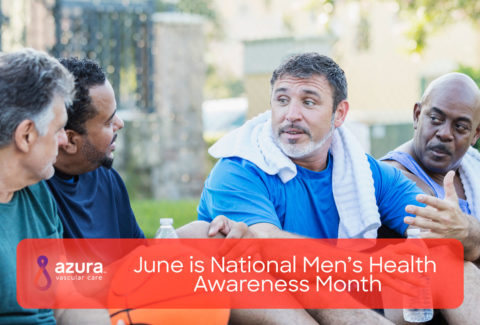
How much do you know about male infertility and the treatment of varicoceles?
If you’ve recently discovered that your husband or boyfriend has a varicocele, a condition present in 15% of men, you should learn about his treatment options.[i] A varicocele is a collection of dilated blood vessels within the scrotum and around the testicles. Among couples with infertility, or couples who’ve been unable to become pregnant after 12 months of unprotected sexual intercourse, 40% will have a varicocele as a factor.[ii]
It’s crucial for you and your partner to realize that there are effective treatments for varicocele related infertility. The diagnosis does not necessarily mean you won’t have children together.
Here is what you need to know about his treatment options, so you can help him navigate the next steps. It’s important you both understand that surgery is not the only treatment option for varicoceles. There is also a minimally invasive procedure known as varicocele embolization.
8 Things You Need to Know About Varicocele Related Infertility Treatment Options
1. Surgery is one option – The surgical treatment for varicoceles is called varicocelectomy and there are several types. Each type involves at least one incision to isolate and close off the veins causing the varicocele.
 Open varicocelectomy – This approach involves an incision in the groin. The blood vessels causing the varicocele are identified and tied off. The varicocele can return in up to 15% of cases.
Open varicocelectomy – This approach involves an incision in the groin. The blood vessels causing the varicocele are identified and tied off. The varicocele can return in up to 15% of cases.- Microsurgical varicocelectomy – This approach also involves an incision in the groin, as with the open approach, but uses a microscope to allow for better visualization of the blood vessels. While the varicocele recurrence rate is low, about 1%, this procedure takes more time to perform than the other approaches.
- Laparoscopic varicocelectomy – This approach involves a specialized camera, or scope, that’s inserted through one incision in the abdomen. Several other incisions are made for surgical equipment. The camera is used to identify the blood vessels so they can be tied off using surgical instruments. The recurrence rate for varicoceles after the laparoscopic procedure is up to 6%.[iii]
RELATED: Is It Really Necessary to Have Varicocele Surgery to Help with My Infertility?
2. General anesthesia may be needed for surgery – General anesthesia involves the use of a breathing machine, because during surgery, the patient is completely unconscious and not breathing on their own. Post-procedure, there is an added risk of confusion and nausea with or without vomiting. General anesthesia must be used with laparoscopic varicocelectomy and may be needed with the open or microsurgical approach.
3. Hydrocele is a complication of surgery – Because surgery involves disruption of the lymphatic drainage, a hydrocele can develop. A hydrocele is a collection of fluid that can become quite large, cause pain, and may require additional surgeries to correct. It occurs up to 9% of the time following open varicocelectomy. Microsurgical varicocelectomy has the lowest risk of hydrocele, less than 1%.[iii]
4. The testicular artery can be injured with surgery – Arteries and veins tend to run closely together in the body. Because they are so close, the artery can be accidentally injured during surgery. The testicular artery carries nutrient and oxygen rich blood to the testicles, and loss of this blood flow can be harmful. This can happen between 12-24% of the time with open varicocelectomy.[iii] It is less likely to happen with microsurgical varicocelectomy; the use of the microscope aids significantly in correctly isolating the arteries. In addition to damaging the testicular artery, arteries in the abdomen can also be injured with the laparoscopic approach.
5. There is an alternative to surgery available – Surgery is not the only treatment option. Varicocele embolization is a minimally invasive procedure that involves the use of image guidance, a type of x-ray, to locate and embolize, or block off the blood vessels causing the varicocele. Varicoceles can be successfully treated 90% of the time using this technique.[iii] Many men opt for varicocele embolization due to the benefits this option has over surgery. After varicocele embolization, there is a shorter recovery time, couples may resume having sexual intercourse sooner and the pregnancy success rate for embolization is comparable to surgery.[iii,v]
6. Recovery from varicocele treatment – The recovery time varies with surgical and interventional treatments.
- It can take 2 weeks to recovery from varicocele surgery.
- With varicocele embolization, most men feel back to normal within 1-2 days and are able to engage in regular activities in 7-10 days.
7. Having sex after varicocele treatment – Following a varicocelectomy, you may need to avoid sexual intercourse for up to 4 weeks. You and your partner would only need to wait for 2 weeks after varicocele embolization to have sexual intercourse. Assuming the procedure goes smoothly, you should have no problems when you resume having sex.
 8. Pregnancy after varicocele treatment is possible – The main reason men tend to consider any varicocele treatment is the possibility of improving fertility. About 3 months after treatment, sperm count can go up and the health of the sperm can improve.[iv] Following varicocele surgery, 26-43% of couples become pregnant.[iii] Varicocele embolization has a comparable pregnancy success rate of 30-50%.[v]
8. Pregnancy after varicocele treatment is possible – The main reason men tend to consider any varicocele treatment is the possibility of improving fertility. About 3 months after treatment, sperm count can go up and the health of the sperm can improve.[iv] Following varicocele surgery, 26-43% of couples become pregnant.[iii] Varicocele embolization has a comparable pregnancy success rate of 30-50%.[v]
RELATED: What Varicocele Related Infertility Means for your Family Planning
Learning as much as you can about the treatment options for varicocele related infertility means you and your partner can make the best decision possible, together.
Sources:
i Choi, W., and Kim, S., Current Issues in Varicocele Management: A Review. World J Mens Health, 2013. 31(1): p. 12-20. http://wjmh.org/DOIx.php?id=10.5534/wjmh.2013.31.1.12 (accessed 7/31/16)
ii American Society for Reproductive Medicine, Male Infertility. http://www.reproductivefacts.org/topics/detail.aspx?id=1331 (accessed 7/31/2016)
iii Kupis, L., Dobronski, P.A., Radziszewski, P., Varicocele as a source of male infertility – current treatment techniques, Cent European J Urol, 2015. 68: p. 365-370. http://www.ncbi.nlm.nih.gov/pmc/articles/PMC4643713/ (last accessed 7/31/2016)
iv Al-Adl, A.M., El-Karamany, T., Issa, H., Zaazaa, M., The influence of antisperm antibodies, intratesticular haemodynamics and the surgical approach to varicoceletomy on seminal variables. Arab Journal of Urology, 2014, 12(4): p. 309-317. https://www.ncbi.nlm.nih.gov/pmc/articles/PMC4435656/ (accessed 8/18/2016)
v Cantoro, U., Polito, M., Muzzonnigro, G., Reassessing the role of subclinical varicocele in infertile men with impaired semen quality: a prospective study. Urology, 2015, 85(4): p. 826-30. http://www.ncbi.nlm.nih.gov/pubmed/25817105 (accessed 8/4/2016)


